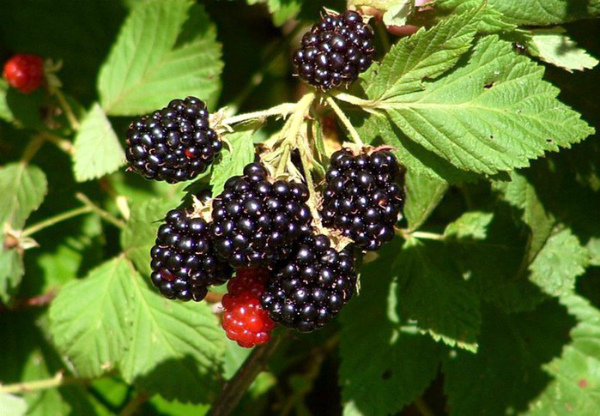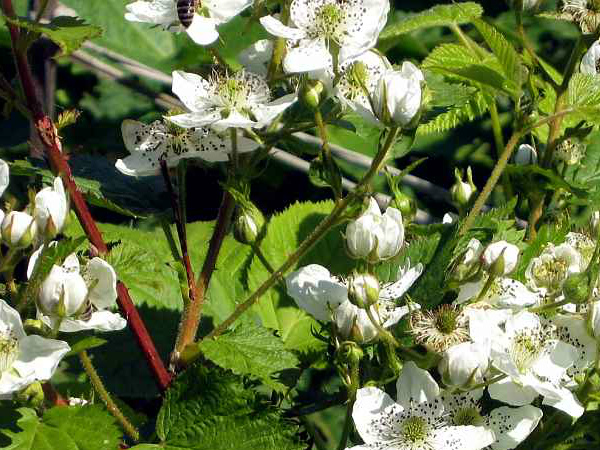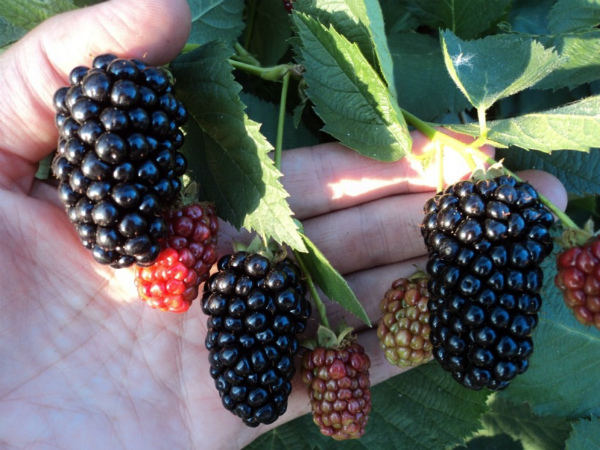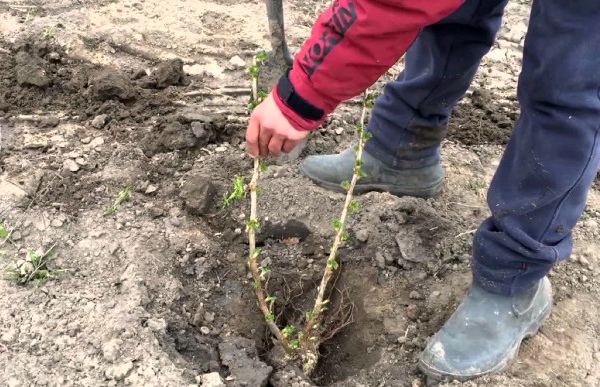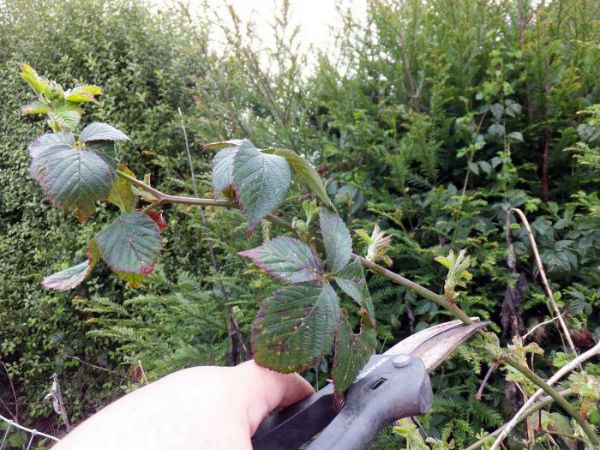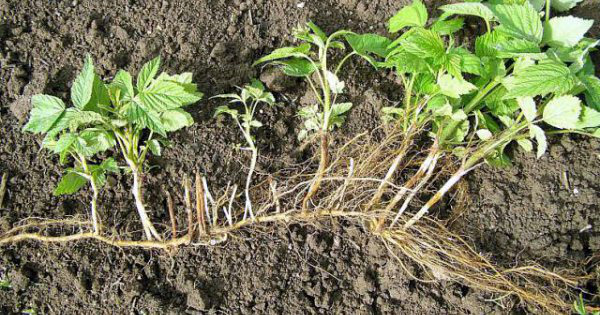Garden blackberries: planting and care
Content
Description
Garden blackberry is a perennial, low (up to 1.5 m) shrub of the Rosaceae family (genus Rubus). Depending on the variety, it has erect or flexible shoots with hard thorns, however, thanks to the active work of breeders, the thornless blackberry is now widespread, characterized by high and stable yields. Well-leafed shrub, trifoliate leaves, 3-5 leaves on a petiole, dentate along the edge, light or intense green color, pubescent on both sides.
Blackberries bloom from the second half of May. The flowers are small (up to 3 cm in diameter), monosyllabic, white, with a pleasant sweet aroma that attracts honey insects. Garden varieties of blackberries are prone to abundant flowering, so in spring the flowering bush has a very attractive external description - it is completely covered with snow-white inflorescences, forming brushes of different lengths.
Blackberry is a prefabricated multicomponent drupe that does not separate from the stalk, as is the case with raspberries. In the process of maturation, it changes color several times: first it is green, then it turns red, turns brown, and at the end it becomes dark blue, almost black. A ripe berry is characterized by a description - a dense structure, a monochromatic color with a matte or bluish bloom, but some hybrids have a shiny surface. The berry tastes sweet, even tart, with a subtle sourness in the aftertaste.
Despite the fact that the berry has recently settled in private gardens, its history has deep roots. The description of the first varieties of blackberry has come down to us since ancient times, when it was only forest, it grew in abundance in forests, in meadows, and people collected it in natural conditions. There was no need to domesticate the berry, moreover, it was too prickly.
Currently, interest in blackberries is unusually high, and every year new varieties are being developed for growing in gardens. As a rule, these are hybrids characterized by high productivity, large berry size and excellent taste. In America and some European countries, the berry is cultivated on vast areas, while in our country it still has no industrial value and is grown only in small farms.
Garden blackberries are subdivided into types and varieties. Depending on the nature of the growth of shoots, the culture is divided into the following types:
- erect;
- creeping;
- semi-creeping - an intermediate form obtained as a result of selection of the two previous species or crossing with raspberries.
Blackberries with erect shoots have smaller fruits, moreover, like a forest, they are very prickly. Creeping species have large and juicy fruits, their shoots are very flexible and can form thickets, which complicates care and harvesting. Semi-creeping varieties are hybrid forms with long, creeping shoots, which, like vines, are capable of trailing along supports (trellises). Blackberries of these varieties are thornless, high-yielding, but more demanding on conditions.
Landing technology
Unlike other berry crops, blackberries are planted in spring or early summer, so that the seedling takes root and takes root before winter.
First of all, you need to decide on a landing site. Since the berry loves warmth and sun, the site should be open to the sun, but protected from wind and drafts. Blackberry grows and bears fruit most successfully on loose, fertile, preferably sandy loam soil. If the soil in your area is heavy, it is necessary to add peat, sand, ash to it - this will increase its drainage properties.
Before planting, the soil is filled with mineral fertilizers and organic matter. If you plan to plant several seedlings, then the entire plot can be dug up and fertilized immediately, and if only one seedling is planted, then fertilizers are poured into the planting pit. The calculation of fertilizers per plant is as follows: 0.5 buckets of humus or compost, 100 g of superphosphate, 40-50 g of potassium. Potassium for blackberries is of great importance - from a lack of this element, the berry becomes sour and not juicy.
Blackberry planting technology is as follows:
- It is necessary to dig a hole 0.5 m deep and 40–45 cm wide.
- At the bottom of the pit, fertilizers are laid, the description of which is presented above, as well as drainage, if necessary.
- Add a part of the earth to the fertilizer in the pit and mix everything thoroughly.
- In the hole, make a small depression (the size of the seedling rhizome), into which a young plant should be placed vertically.
- Spread the roots and sprinkle with earth so that the lower bud is no more than 2-3 cm deep.
- Compact the earth, make a shallow furrow around the seedling, into which to pour 1-2 buckets of water.
- To prevent the soil from drying out, a thin layer of mulch (peat, sawdust, humus) is laid around the plant.
Video "How to plant a blackberry correctly"
In this video, a plant expert explains how to plant and care for blackberries.
Care features
In general, the blackberry berry is unpretentious, but its cultivation has some peculiarities. In addition to the main care, which consists in watering, loosening the near-stem circles, removing weeds and periodic feeding, the culture needs additional measures that directly affect its yield.
First of all, this is pruning shoots. It is held in early spring from the second year of life. When the stems reach a length of 100–120 cm, they must be shortened by 10–20 cm. This procedure allows you to increase the growth of lateral shoots and thereby increase the productivity of the crop. In addition, when pruning, weak, diseased, as well as old two-year-old shoots are necessarily removed - the berry will no longer ripen on them.
They feed blackberries from the second year of life. Fertilizers are applied several times during the season. In early spring, to accelerate the growing season, you can add humus (5-6 kg / 1 bush) and a little saltpeter (40-50 g). As soon as the bush blooms, it is necessary to feed it with potash fertilizer or a complex mixture (superphosphate). Before the onset of cold weather, the trunks are mulched with humus, compost.
Periodically, the soil around the bush needs to be loosened - this will provide air and moisture access to the roots. As for watering, they are necessary for the plant in the first year of life, and then it is necessary to water it as needed - blackberry is a moisture-loving culture, but if the soil in which it grows is excessively moist, then root rot may occur.
For the winter, garden blackberries need shelter. If the winter temperature in your region does not exceed -20 ° C, then you can get by with a dense layer of organic matter. The culture loves slightly acidified soil, so it is better to use peat, sawdust, and pine needles as mulch. In regions with a harsh climate, in addition to mulch, the bushes must be covered more reliably: with agrofibre, roofing felt or other insulating materials.
Reproduction
The culture is highly reproductive. An ordinary garden berry, like a forest berry, is capable of rapidly reclaiming a site itself, forming dense thickets on it.
There are several ways to breed blackberries, but it all depends on the variety:
- creeping blackberries can be propagated by horizontal or apical layers;
- bush propagated by offspring, cuttings, dividing the bush.
To propagate a culture with an apical layer, you need to bend the young shoot and dig its top to the ground. It is better to do this in the spring, while the buds have not yet blossomed - in this case, the top will quickly release the roots, after which it will be possible to separate the shoot from the bush.
When propagating by horizontal layers, the principle is the same, only the shoot is sprinkled with earth along its entire length. As a result, the roots sprout in several places, forming several bushes at the same time. Then the shoot is divided into parts and the seedlings are transplanted to a permanent place.
Offspring are young shoots that have sprouted from the root. For separation and transplantation, only processes that have reached a height of 10-15 cm are used.
The process is very simple: you just need to separate the process along with the root from the bush and transplant. It is better to transplant in June or early July, so that the seedling has time to take root in a new place before the frost.
By dividing the bush, varieties that do not give off shoots are propagated. To do this, you need to carefully dig out the bush, divide it into several parts so that each one has well-developed roots, and then plant it in a new place. The method is recommended for use in the fall.
Cuttings are used when it is necessary to propagate valuable varieties with high taste and market characteristics. The process is a bit troublesome, but generally uncomplicated. At the end of June, small (10–12 cm) cuttings with several buds or leaves should be cut from the upper part of the shoot. Put them with a lower cut for several hours in a solution that accelerates root growth (Kornevin, Heteroauxin), and then plant them in a garden bed or in small cups under a film. For successful root germination, high humidity must be maintained. Typically, seedlings take root within a month.
There is another way to propagate blackberries, which is very rarely used - these are seeds. Yes, some varieties retain their valuable varietal characteristics well through seeds. For example, in this way, forest blackberries are often propagated in natural conditions, but since in the case of horticultural crops there are easier and more affordable methods of reproduction, the seed method is practically not used.
Video "Reproduction of garden blackberries"
This video will introduce you to a very simple way of growing climbing blackberry planting material.


